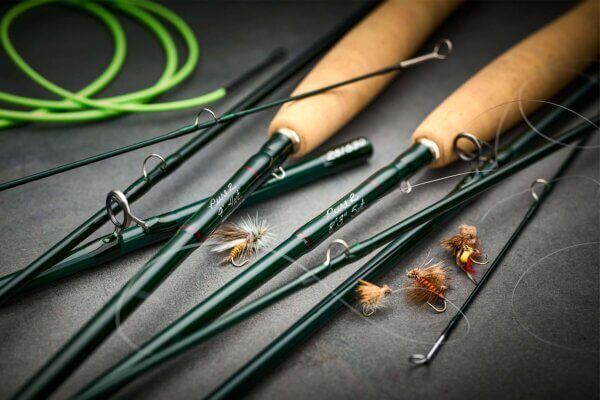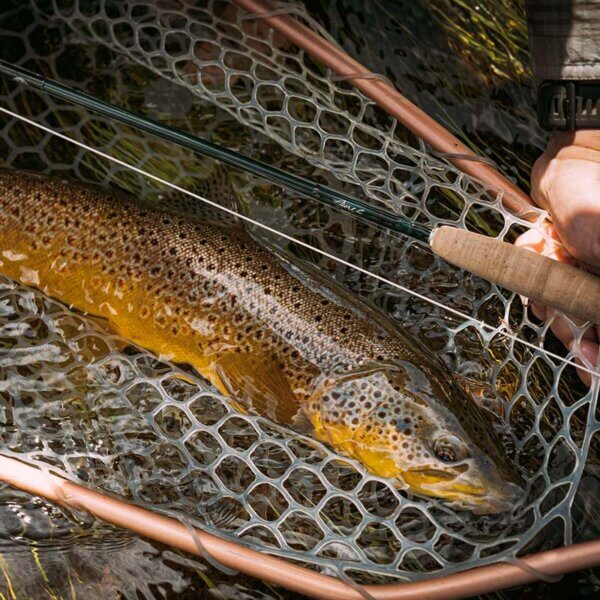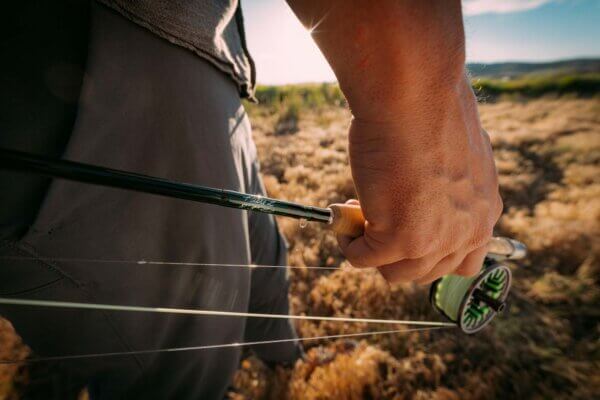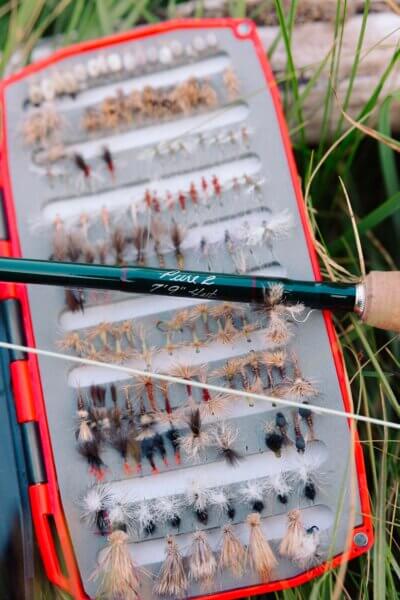article by John Duncan
reviews from Parker Thompson, Richard Post and John Duncan
Jump Straight to Model Reviews
 Nature of the Winston Pure 2
Nature of the Winston Pure 2
There is an easy-to-identify, fundamental design difference between the Pure and Pure 2 series. The original Pure models were designed with stiff tips and soft mid sections, flexing to the center of the rod on every cast, regardless of distance. They had a lovely old fashion action, the rod doing its own thing with the caster more or less a bystander. We liked these rods because they expressed a strong point of view reminiscent of bamboo, but the Pure 2 series are much more refined angling tools. Pure 2 models have noticeably lighter tips relative to their mid and butt sections, so the rod doesn’t fold into the mid-section until a commensurate amount of line is in the air. The top 3 sections of Pure 2 rods all flex deeply. The rods cast progressively from short to long but with an overall deep load and feeling of connectedness to the fly line. Superb loop control and moderate line speed offer an elite ability to manipulate one’s presentation.
Designed specifically for dry fly fishing, each Pure 2 model has an appropriate action for its length and fishing purposes. Many anglers will ask whether Pure 2 rods can handle a dry-dropper or light nymphs. The answer is yes, but we wouldn’t specifically recommend a Pure 2 for all-around techniques. These rods excel in dry fly fishing, and the more technical the better, whether draping a 16-foot leader over a midging monster or tucking hoppers under tight willows from a current-bound driftboat. These are rods that put the operator in complete control, like a 5-speed stick or Leica camera. Experienced anglers will hold the greatest appreciation for these qualities, painting silky, sneaky, creative presentations to the toughest fish on their sacred waters.
Winston’s proclivity for unique rod lengths offers something for every angler. Many will head straight for a 9’ model, but the light line rods ranging from 6’9” to 8’ 3” are all wonderful fly rods. In fact, it’s plausible that Winston landed on these lengths because the prototypes were simply undeniable. The small water angler has many compelling choices in this series. Strongly consider one of these unconventional models for spring creeks, alpine creeks and other waters where precision supersedes power.
We’ll go deeper in model reviews, along with line pairings that bring the best qualities out of each rod.

Model-by-Model reviews
Pure 2 7’3” 2-wt
John Duncan: One of my favorite rods in the series, the Pure 2 7’3″ 2-weight is everything it’s supposed to be and nothing it isn’t. I cast it with both an SA Amplitude DT2 and also an SA Trout Standard WF2 line and loved them both. The rod casts with lilting grace to about 35′, then we’re finished. The WF Trout Standard can shoot beyond 35′ in a pinch, but there is no need. This is a creek rod. The criteria for a rod like this are 1) how does it feel? and 2) is it well-designed? The trademark Winston touch weeps from every pore of this wonderful ultra-light fly rod, ponderous elasticity tickling your palm on every swing. It feels like a 2-weight and fishes like a 2-weight. Especially with the benefit of water loading, the rod fishes supremely at short distances and turns over 9-10′ leaders with natural accuracy. It performs beautifully on small water but won’t cross over to tailwater fishing or broader waters because a 7’3″ fly rod simply can’t engage a long leader. Versatility would compromise purpose, but the flex profile and relationship between each part of this fly rod are immaculately tuned. The overall action, progressive load, lightness throughout the blank and response to input from the angler are in the top percentile of any light line fly rod, truly a joy to fish. This is one of the finest graphite creek rods I have handled, a rod I will fish alongside my favorite fiberglass rods on the cutthroat streams of SW Colorado.
Pure 2 6’9” 3-wt
John Duncan: Playful and springy, the Pure 2 6’9″ 3-weight has a range of 10′-30′, a dedicated creek rod for the angler who prefers graphite over fiberglass. There is no characteristic of stiffness in this rod. Even with 10 feet of line in the air, it flexes into the 2nd section, so you never feel the blunt stubbiness of many shorter graphite rods. It’s a little more bouncy than the 8’4″ 3-weight and some of my other favorites in the series, but a creek rod of this specialized length needs to be eager to flex with the slightest input from the caster. This is a great rod on the water, but hard to appraise in the parking lot. The Winston feel produces an involuntary smile when I cast this little rod. I generally prefer fiberglass for true creek rods, but I would reach for this rod without hesitation because it fishes with the same playful character.
Pure 2 7’9” 3-wt
John Duncan: It’s unusual for a rodmaker to create a series with just 8 models but 5 rod lengths (compare with the G.Loomis Asquith, which has 9 models but only 1 rod length). The motivation here is to completely canvas small water applications. I also think Winston was experimenting with unique configurations and fell onto some prototypes that they simply couldn’t “uncast.” The rods had to go in the catalog.
Consider rod length carefully when making your choice. The 6’9” 3-weight is the dedicated creek rod, a model that compares with fiberglass for its capabilities at 10-25 feet. At 7’9”, this particular model is a small water all-arounder, not too long for creeks but also not too short for low water conditions on our favorite wade fishing freestones like the San Miguel and Dolores. If you seek a short 3-weight with more versatility than a sub-7’ creek special, this is your rod.
The SA Trout Standard is the ideal line on the Pure 2 7’9” 3-wt. It feels light and casts tight loops up to about 30 feet, then exits the rod cleanly with pleasing line speed for turning over your fly. I loved the regular SA Trout too, but the long head (over 60 feet) becomes a little too much with casts over 30 feet. The rod wants to shoot line at that point, rather than carry more line in the air. At shorter distances, both of these lines cast with surprising line speed, reminding me of the Air 2 series, which has no short 3 or 4-weight models. A Rio Technical Trout or Rio Gold will load the rod deeper for boot-top casts on the creek.
 Parker Thompson: The new 7’9” 3wt Pure 2 from Winston is an extremely capable small water rod. It has great feel in close and is wonderfully accurate at all distances. The rod itself is very light and responsive, throwing much tighter loops than other short 3wt rods. I was impressed with the overall range of this rod. Naturally it feels great in close but it also has the ability to make beautiful casts at distance which can sometimes be difficult with shorter rods. It’s a lethal small water dry fly rod. I played around with a few different fly lines on this rod and they all seemed to get the job done. In general, the Rio Elite Technical Trout WF3F loads well in close but puts a little too much bend in the tip for my liking. The SA Amplitude Trout WF3F takes a little more energy to engage the blank but feels spectacular at distance and will give you the tightest loops. The SA Amplitude Trout Standard WF3F fits nicely between the other two lines and will likely be the best option for most anglers.
Parker Thompson: The new 7’9” 3wt Pure 2 from Winston is an extremely capable small water rod. It has great feel in close and is wonderfully accurate at all distances. The rod itself is very light and responsive, throwing much tighter loops than other short 3wt rods. I was impressed with the overall range of this rod. Naturally it feels great in close but it also has the ability to make beautiful casts at distance which can sometimes be difficult with shorter rods. It’s a lethal small water dry fly rod. I played around with a few different fly lines on this rod and they all seemed to get the job done. In general, the Rio Elite Technical Trout WF3F loads well in close but puts a little too much bend in the tip for my liking. The SA Amplitude Trout WF3F takes a little more energy to engage the blank but feels spectacular at distance and will give you the tightest loops. The SA Amplitude Trout Standard WF3F fits nicely between the other two lines and will likely be the best option for most anglers.
Pure 2 7’9” 4-wt
Richard Post: I lined up the SA Trout first and right away I found the rod had an almost supernatural ability, even an affinity, for turning over a leader. The tip of the rod follows through perfectly and exactly as the rod unloads on the forward cast. I did feel like the SA Trout was a little long and light and required a pretty hard stop to fully engage the rod, but the rod performed very well with a little casting adjustment. The taper is remarkably fine for a sub-8’ graphite rod, no bounce at all, limber but not loose. The Rio Elite Tech Trout brought out the best in the rod and I really enjoyed the combination with more engagement along the blank and a crisp, tight loop springy-ness that was a pure pleasure. It was windy, definitely a poke past breezy, and I felt confident in the wind; not commanding, but this shouldn’t be that kind of stick. The next line I’d like to cast on here is the SA Trout Standard. The head on the Rio Tech Trout is a little longer than you would need with this specialized 4 weight, although the rod handles it exceptionally well. This is a great short 4 weight for pulling a bigger fish out of a small place.
Parker Thompson: This may very well be my favorite rod in the Pure 2 lineup. It is a unique length for a 4wt but doesn’t feel out of place at all. This is the perfect rod for someone fishing for larger fish in smaller water. It throws dagger loops for a 4wt but is still very much a presentation-based fly rod. If you need to get your fly in a tight spot with minimal room for a back cast this rod is the perfect tool for the job. It roll casts well in close and is a breeze to sidearm cast. Both techniques are essential when it comes to fishing tighter quarters. I have been lucky enough to play around with a few lines on this rod but my favorite by far is the SA Amplitude Trout Standard WF4F, which loads the rod in close and still holds a nice tight loop on longer casts.
Pure 2 8’3” 4-wt
John Duncan: This rod shows how much fun we can have in this sport. It’s the perfect balance of length and lightness, a versatile and unique 4-weight that will fish all the mid-sized water with leaders up to about 13 feet. I just love it. When I saw these two models on the list (8’3” 4 and 5-weights), I was full of hope because I could imagine fishing them all over SW Colorado. Here they are, two of the finest Winstons I’ve ever cast. The 4-weight is terrific with an SA Trout taper up to about 50 feet at which point its length limits range. A Rio Technical Trout loads the rod slightly deeper but with no loss of control. The SA Trout makes the rod feel lightest but the Rio Tech Trout generates a tad more momentum for longer leaders or dry-dropper combinations.
The action of this rod is ideal for its length. I expect a mid-length 4-weight to handle leaders of at least 12’ and throw with accuracy and control to around 45-50 feet, but also to load and deliver short, forming casting loops with very little line in the air, that feeling of delicacy in a truly light rod tip. This rod has it all, plus an X factor that I find in so many Winston trout rods: a springy, touchy, elegant sensation that becomes stronger as more line is cast within the optimal range for the rod. Once you feel it, you can’t forget it.
I’m searching my memory for any previous experience with an 8’ 3” fly rod. If this length is even remotely applicable to your fishing, you must try this rod. Wow.
 Richard Post: This rod will go down as one of the all-time Winstons. There will be people who lament the loss of the 804 and 864 Pure rods, both great rods that should peak one’s curiosity about this new model. Please go and cast this rod, especially if you own the other two. When I got the line right on this model, I felt like I had found a time machine or genie’s lamp. The Rio Elite Technical Trout is the line for this rod in my opinion. The SA Trout was ok, but like the Pure 2 794, I felt like the line and rod weren’t completely in sync and I wanted more engagement between the two. Lined up with the Rio Elite Technical Trout the Pure 2 834 was magical, complete connectivity with the rod with every inch of both rod and line in unison. Really lovely. Line speed traveled off the tip in a manner that told you how many inches are exiting while asking politely how many more or less would you prefer? I never tried to hero-cast this rod but I definitely cast it far into the wind, several times, like over and over again. It delivers perfect loop formation with intuitive timing and load recognition that is automatic but leaves me in the driver’s seat. This is a rod you will cast better because it wants to make a perfect cast. This rod will definitely find a home on the Dolores and San Miguel rivers and is my favorite of the 4s and 5s in this series.
Richard Post: This rod will go down as one of the all-time Winstons. There will be people who lament the loss of the 804 and 864 Pure rods, both great rods that should peak one’s curiosity about this new model. Please go and cast this rod, especially if you own the other two. When I got the line right on this model, I felt like I had found a time machine or genie’s lamp. The Rio Elite Technical Trout is the line for this rod in my opinion. The SA Trout was ok, but like the Pure 2 794, I felt like the line and rod weren’t completely in sync and I wanted more engagement between the two. Lined up with the Rio Elite Technical Trout the Pure 2 834 was magical, complete connectivity with the rod with every inch of both rod and line in unison. Really lovely. Line speed traveled off the tip in a manner that told you how many inches are exiting while asking politely how many more or less would you prefer? I never tried to hero-cast this rod but I definitely cast it far into the wind, several times, like over and over again. It delivers perfect loop formation with intuitive timing and load recognition that is automatic but leaves me in the driver’s seat. This is a rod you will cast better because it wants to make a perfect cast. This rod will definitely find a home on the Dolores and San Miguel rivers and is my favorite of the 4s and 5s in this series.
Pure 2 8’3” 5-wt
Richard Post: Perfection, and cut from the same cloth as the 834 Pure 2, the 8’3” 5 weight Pure 2 is a special rod. I cannot recall another 8 foot 3 inch 5-weight and I appreciate the uniqueness. I like the light and playful nature of the blank. The rod bends deeper than you would expect from a short 5-weight. The opposite of clubby, this rod possesses a fine taper that seems to wrap up the line like a hug from a towel fresh out of the dryer, crisp and comfortable with control and intuition in spades. It is a specialized rod, ideal in smaller, tighter waters with fish that need to be pulled. The loops are so flat and level, giving you that frozen-in-time effect as you watch the line unroll. You can keep them tight to your body and above the rod tip effortlessly. East coast big trout in small waters and sneaky western floats, the kind with loose to nefarious permissions: those are situations I’d like to have one of these. If anything, I bet you don’t own an 8’3” 5-weight and this is a good one.
John Duncan: Oh yeah, we have something here. Like the 8’3” 4-weight, this sensational short 5-weight is immaculately designed for its purpose. The Winston feel drips from this thing. It’s so light and illuminating to cast, I know anglers will reach for this rod when they might have chosen a favorite 3 or 4-weight. It’s playful in the extreme, but also purposeful, especially for tucking medium sized dry flies into tight places. Winston says they designed this model for the Beaverhead. It’s equally useful on all tight rivers whether fishing a hopper, smaller single or double dry fly, or even a light dry-dropper. What a great rod for our San Miguel River. The length of this 5-weight will limit mending ability with long leaders but optimize accuracy with high-floating dry flies fished along grassy banks or in smaller pocket water environments. Pair it with an SA Amplitude Trout Standard which loads the rod evenly but also exits the rod tip with greater shooting momentum than long-headed lines.
Pure 2 9’ 4-wt
Parker Thompson: This is your classic long leader dry fly 4wt. It has the best feel of all the rods in the Pure 2 lineup and is silky smooth. If you prefer a longer and slower, 4wt this is an excellent choice. It mends and roll casts better than almost any other 9’ 4wt on the market and flexes deep into the blank, a rod that any Winston fanatic is sure to adore. It is not going to be the rod you want to reach for if it is overly windy, but when the conditions are right and the fish are looking up, you’ll have a hard time finding another rod that is as well suited for the job. Of all the lines I threw on this rod, the SA Amplitude Trout is my personal favorite. It pairs very well with the slower rod and doesn’t flex the tip as much as a heavier headed line.
 John Duncan: This model lends itself to artistry on long leader presentations. If you’re the angler who fishes dries on the Missouri, Green, San Juan or Delaware while all others are running strike indicators, this rod was designed for you. The difference in actions between the Pure and Pure 2 series is most evident in the 9’ rods. The improvement in loop control and range is undeniable in this model, an elegant, silky caster from 20’ to 60’. It has a lighter tip and more even flexing profile than the original Pure (we often refer to “even flex” as “progressive”), loading deeply with a cellular connection to the line, imparting a remarkable feel of control. Line speed builds gradually in the cast. Rather than jerking the line with each casting stroke, an open loop tightens with distance, which helps turn over a long leader without causing a tailing loop. Casting this rod feels like draping the presentation delicately before a rising fish, lightly placing the dry fly with one’s fingertips. You can’t push this rod in the wind, knock tight loops off the tip or otherwise change its nature as a medium-slow action fly rod, but it’s a paintbrush with the finest bristles that has masterpiece potential on the river.
John Duncan: This model lends itself to artistry on long leader presentations. If you’re the angler who fishes dries on the Missouri, Green, San Juan or Delaware while all others are running strike indicators, this rod was designed for you. The difference in actions between the Pure and Pure 2 series is most evident in the 9’ rods. The improvement in loop control and range is undeniable in this model, an elegant, silky caster from 20’ to 60’. It has a lighter tip and more even flexing profile than the original Pure (we often refer to “even flex” as “progressive”), loading deeply with a cellular connection to the line, imparting a remarkable feel of control. Line speed builds gradually in the cast. Rather than jerking the line with each casting stroke, an open loop tightens with distance, which helps turn over a long leader without causing a tailing loop. Casting this rod feels like draping the presentation delicately before a rising fish, lightly placing the dry fly with one’s fingertips. You can’t push this rod in the wind, knock tight loops off the tip or otherwise change its nature as a medium-slow action fly rod, but it’s a paintbrush with the finest bristles that has masterpiece potential on the river.
A gradual line taper is a must on this rod. The Scientific Anglers Trout taper casts beautiful loops at distance but requires a deliberate casting stroke to form tighter loops under about 40 feet. It’s a great line choice for windy conditions where the angler is already inclined to cast with more power. Under calm conditions, I prefer the Rio Elite Technical Trout which loads the rod just a little bit deeper with a relaxed casting stroke. With either line, the caster will use a long, accelerating casting stroke to build line speed. Choosing a line for myself, it would be the Rio Technical Trout.
Pure 2 9’ 5-wt
 Richard Post: I preferred the 5-weight in the 9-foot rods. It shares characteristics with the 904 Pure 2, but fit my casting style and speed a shade better. I paired it with the Rio Technical Trout and my first note on the legal pad immediately after casting was, “supple coy energy,” followed by, “hit it softly for best results.” The long arm, gradual acceleration casting style was the right fit. It was windy, so the #5 was going to shine over the #4, and my loops unrolled with more confidence. A good springy character and playful looseness kept me engaged and focused. The more I cast it, the more I liked it. I felt like the 905 had a more progressive taper towards the tip while still accentuating the bend of the fly rod. The 9-footers really savor the bend of the rod through the casting stroke. I would fish this rod as a technical dry fly rod first. The Ranch water on the Henry’s Fork, after work dries on the Roaring Fork in Glenwood and last light on your favorite home water with a Parachute Adams are places this rod would be real happy.
Richard Post: I preferred the 5-weight in the 9-foot rods. It shares characteristics with the 904 Pure 2, but fit my casting style and speed a shade better. I paired it with the Rio Technical Trout and my first note on the legal pad immediately after casting was, “supple coy energy,” followed by, “hit it softly for best results.” The long arm, gradual acceleration casting style was the right fit. It was windy, so the #5 was going to shine over the #4, and my loops unrolled with more confidence. A good springy character and playful looseness kept me engaged and focused. The more I cast it, the more I liked it. I felt like the 905 had a more progressive taper towards the tip while still accentuating the bend of the fly rod. The 9-footers really savor the bend of the rod through the casting stroke. I would fish this rod as a technical dry fly rod first. The Ranch water on the Henry’s Fork, after work dries on the Roaring Fork in Glenwood and last light on your favorite home water with a Parachute Adams are places this rod would be real happy.
Parker Thompson: The two 9’ Pure 2 rods feel like they belong in their own rod series. They are slower than the others in the lineup and are by far the smoothest. This rod will fish a longer leader significantly better than the shorter 5wt in the family and is a breeze to roll cast. It can handle bigger dry flies and lighter nymphs but it will really feel happiest with a long leader and a medium sized single dry fly. This rod won’t handle the super windy days as well as a rod like the Air 2 9’ 5wt but when the wind is minimal it is a lovely fishing tool. If you are looking for a tight loop 5wt the 8’3” version is a better bet. If you like a silky smooth rod, the 9’ 5wt is a great choice. I played around with a couple of different lines on this rod and the SA Amplitude Trout WF5F felt best to me.
This is a great review, well written and informative. Especially the comments on the 794 & 835, right on the money in my experience with these fantastic new dry fly sticks. Thank you!